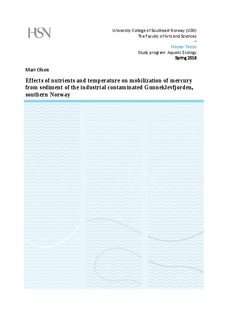| dc.description.abstract | Mobilization of mercury (Hg) and Hg methylation rates in sediment and water from the contaminated fjord Gunneklevfjorden, Telemark, Norway, were investigated in a laboratory experiment with addition of nutrients (as glucose (C6H12O6) and ammonium (NH4+)) to the water in 56 different treatments under two different temperature regimes (4ºC and 20ºC). After storage for four months, the concentration of total Hg (TotHg) and methylmercury, CH3Hg+ (MeHg), in water above the contaminated sediment were measured in the different treatments. Correlations were assessed between TotHg/MeHg and nutrient consumption, redox potential (Eh), sulfate (SO4 2-)- and sulfide (S2-) concentrations, as well as other possible influencing variables such as pH, nitrate (NO3--N) and total phosphorous (Tot-P). The amount of nutrients added and nutrient consumption were strongly correlated (p = < 2.2 × 10-16 for both glucose and NH4 +), indicating a stimulation of bacterial activity with increasing nutrient availability. The Eh 1 cm above the sediment surface (Eh(1)) was significantly negatively correlated with nutrient consumption (α = 6.9 × 10-9 and α = 0.0023 for glucose and NH4+, respectively) and significantly lower at storage temperature 20°C (α = 0.0152), indicating that enhanced bacterial activity reduced the amount of oxygen above the sediment, and thereby lowered Eh(1). A significant negative correlation between consumed glucose and SO42- concentrations in the water (α = 3.3 × 10-9) indicated presence of sulfate-reducing bacteria (SRB), further demonstrated by a significant negative correlation between S2- 1 cm below the sediment surface (S2-(-1)) and SO42- in the water (p = 0.0088). TotHg concentrations in the water after storage showed a large variation, ranging from 1.9 - 74.8 ng L-1. Storage temperature appeared to be the strongest explanatory variable for TotHg, with a significant difference between TotHg at 4ºC (34.2 ± 22.9 ng L-1) and 20ºC (9.1 ± 3.8 ng L-1) (p = 5.9 × 10-6). MeHg concentrations in the water after storage ranged from below detection limit (DL: 0.02 ng L-1) to 8.60 ng L-1. In a multiple regression model fitted for MeHg, Eh(1) and storage temperature explained 50 % of the variations in MeHg (interpreted by R2 = 0.50). There was no significant correlation between NH4+ consumed and MeHg (p = 0.2563). Thus it was assumed that NH4+ did not directly affect the bacterial MeHg formation. | |
